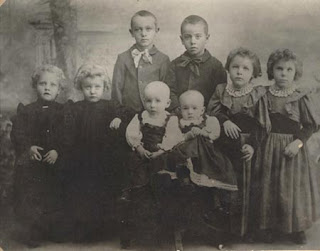OK, so we've gone over the basic facts of twinning with my potted biology lesson with the things you might never have known about multiples, so next I thought I'd tackle some of the myths!
You have to have a history of twins in your family to have them yourself.
Actually, anyone can have twins - they do not have to run in families! Some twins do run in families, but only non-identical twins. This is because you can inherit the likelihood of releasing two or more eggs at ovulation, whereas identical twins are completely random.
 |
| Photograph copyright Deana Smith |
There are twins all over my husband/partner's side of the family so I'm bound to have them.
As above, a woman can inherit the likelihood of producing multiple eggs making twins more likely, but this can only come from her side of the family - twins on the man's side have no bearing on whether he will have multiples himself.
Identical twins have to look identical otherwise they are fraternal
Whilst at first glance twins may look the same, the term "identical" is really referring to their DNA rather than appearance. ID twins are only exact copies of each other when the egg first splits. From then on, different parts of their DNA get switched on and off due to external factors meaning that some identical twins can end up being really quite different! For example, I think my twins look similar but not at all the same, despite being MCDA (remember that term?!). They also have different personalities, strengths and weaknesses - definitely not exact clones of each other!
Twins are usually opposites
For some reason, many people seem to think that twins should be opposites of each other and like to label them "the loud one", "the quiet one", "the good one", "the naughty one". In reality, most twins are a mix of personality traits and if mine are anything to go by, every time you think you've got them pegged, they swap!
Twins happen because a man has "supersperm"
This is one for the boys! Sorry to disappoint lads, but I'm afraid current medical thinking is that you have nothing to do with the miracle of twins, despite all the back-slapping and guffawing that often accompanies a man's announcement that he is about to become a father of twins! As was so charmingly expressed to my husband while I was pregnant: "well done mate - two birds, one stone!"
Boy-girl twins can be identical
Unless someone's talking about the super rare instance of "polar body twinning" and I'd be surprised if they were, I'm afraid no, they can't! Apart from the rather obvious(!) differences, a male and a female cannot share identical DNA and can therefore not be produced from a single egg. Even if they look very similar!
Twins are double the trouble
Having twins can be hard, I won't lie. But they are certainly not "double trouble"! There are so many fantastic things about having twins that you wouldn't get to experience otherwise. Twins are actually double the joy...most of the time!
Next up: things to avoid saying to a mother of multiples!


